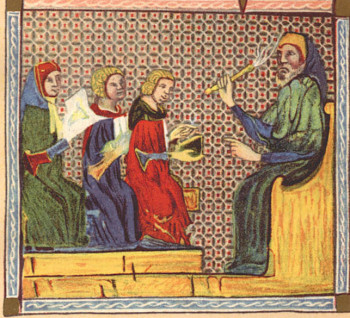It is certain that these free and public discussions of the Jews tended to create a high degree of general intelligence among the people. The students, like young Paul, were trained there in a system of excellent dialectics and they learned to express themselves in a rapid and sententious style, often with much poetic feeling. They also acquired an admirable acquaintance with the words of the ancient Scriptures which would make anyone wise.
These "assemblies of the wise" who would teach Paul were possibly a continuation of the "schools of the Prophets" which are mentioned in the historical books of the Old Testament (1Samuel 10:5, 6, 19:20, 2Kings 2:3, 5, 4:38). Wherever the earlier meetings were held, whether at the gate of the city, or in some more secluded place, we read of no buildings for purposes of worship or instruction before the captivity of Israel and Judah.
During that melancholy period, when the Jews mourned over their separation from the Temple, the necessity of assemblies must have been deeply felt for united prayer and mutual exhortation. When they returned, the public reading of the law became a practice of universal interest. Although synagogues are not mentioned by Josephus in any of the earlier passages of his history, the New Testament records that they existed in all the small towns in Judea, and in all the principal cities where the Jews were dispersed abroad.

It seems that the synagogues, like those frequented by Paul, often consisted of two apartments. The first was used for prayer, preaching, and the offices of public worship. The other was utilized for the meetings of learned men, for discussions concerning questions of religion and discipline, and for purposes of wise education. Thus the Synagogues and the Schools cannot be considered as two separate subjects.
No doubt a distinction must be drawn between the smaller schools of the country villages and the great divinity schools of Jerusalem that Paul attended. The synagogue which was built by the Centurion at Capernaum (Luke 7:5) was unquestionably a far less important place than those synagogues in the Holy City, where "the Libertines, and Cyrenians, and Alexandrians, with those of Asia and Cilicia" (Acts 6:9) rose up as one man, and disputed against Stephen's wisdom.
The Rabbinical writers say that there were 480 synagogues in Jerusalem. Although this is almost certainly an exaggeration, yet no doubt all shades of Hellenistic and Aramaic opinions found a home in the common metropolis. It is easy to see that an eager and enthusiastic student like Paul could have had no lack of excitements to stimulate his religious and intellectual activity, especially if he learned "at the feet of Gamaliel" (Acts 22:3).
Teaching wisdom
It has been contended, that when apostle Paul said he was "brought up" in Jerusalem at the feet of Gamaliel, he meant that he had lived at the Rabban's house and eaten at his table. But the words evidently point to the customary posture of Jewish students at a school. There is a curious passage in the Talmud, where it is said, that "from the days of Moses to Rabban Gamaliel, they stood up to learn the law; but when Rabban Gamaliel died, sickness came into the world, and they sat down to learn the Law."
"To sit at the feet of a teacher" was a proverbial expression, as when Mary is said to have "sat at Jesus' feet and heard His word" (Luke 8:35, 10:39). But the proverbial expression must have arisen from a wellknown custom. The teacher was seated on an elevated platform, or on the ground, and the pupils around him on low seats or on the floor. Maimonides says the following.
"How do the masters teach? The doctor sits at the head, and the disciples surround him like a crown, that they may all see the doctor and hear his words. Nor is the doctor seated on a seat, and the disciples on the ground; but all are on seats, or all on the floor."
St. Ambrose says, in his Commentary on the First Epistle to the Corinthians, that "it is the tradition of the synagogue that they sit while they dispute; the elders in dignity on high chairs, those beneath them on low seats, and the last of all on mats upon the pavement." And again Philo says, that the children of the Essenes sat at the feet of the masters, who interpreted the law, and explained its figurative sense. And the same thing is expressed in that maxim of the Jews, "Place thyself in the dust at the feet of the wise." Thus was Paul taught to be wise.